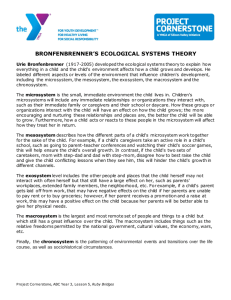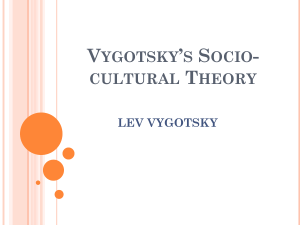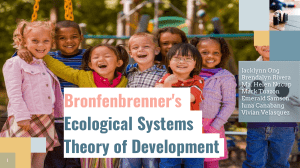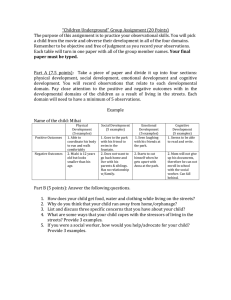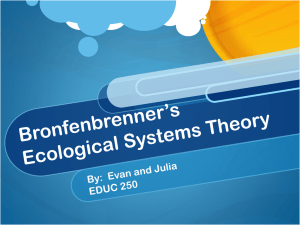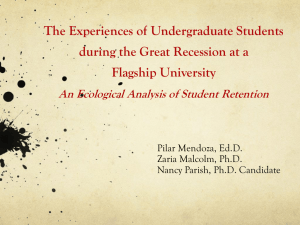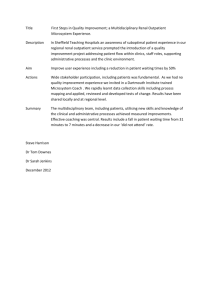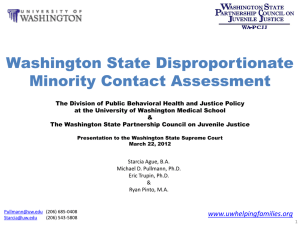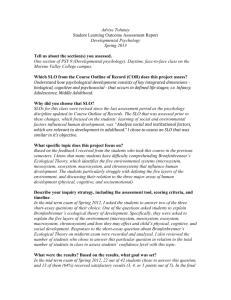here.
advertisement
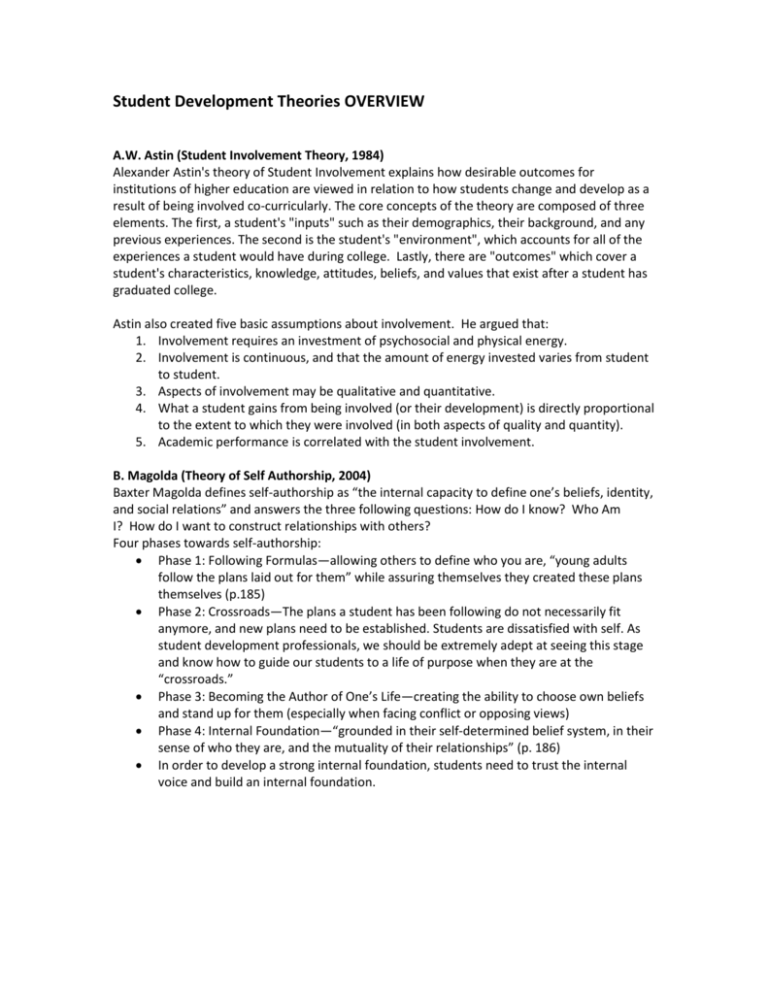
Student Development Theories OVERVIEW A.W. Astin (Student Involvement Theory, 1984) Alexander Astin's theory of Student Involvement explains how desirable outcomes for institutions of higher education are viewed in relation to how students change and develop as a result of being involved co-curricularly. The core concepts of the theory are composed of three elements. The first, a student's "inputs" such as their demographics, their background, and any previous experiences. The second is the student's "environment", which accounts for all of the experiences a student would have during college. Lastly, there are "outcomes" which cover a student's characteristics, knowledge, attitudes, beliefs, and values that exist after a student has graduated college. Astin also created five basic assumptions about involvement. He argued that: 1. Involvement requires an investment of psychosocial and physical energy. 2. Involvement is continuous, and that the amount of energy invested varies from student to student. 3. Aspects of involvement may be qualitative and quantitative. 4. What a student gains from being involved (or their development) is directly proportional to the extent to which they were involved (in both aspects of quality and quantity). 5. Academic performance is correlated with the student involvement. B. Magolda (Theory of Self Authorship, 2004) Baxter Magolda defines self-authorship as “the internal capacity to define one’s beliefs, identity, and social relations” and answers the three following questions: How do I know? Who Am I? How do I want to construct relationships with others? Four phases towards self-authorship: Phase 1: Following Formulas—allowing others to define who you are, “young adults follow the plans laid out for them” while assuring themselves they created these plans themselves (p.185) Phase 2: Crossroads—The plans a student has been following do not necessarily fit anymore, and new plans need to be established. Students are dissatisfied with self. As student development professionals, we should be extremely adept at seeing this stage and know how to guide our students to a life of purpose when they are at the “crossroads.” Phase 3: Becoming the Author of One’s Life—creating the ability to choose own beliefs and stand up for them (especially when facing conflict or opposing views) Phase 4: Internal Foundation—“grounded in their self-determined belief system, in their sense of who they are, and the mutuality of their relationships” (p. 186) In order to develop a strong internal foundation, students need to trust the internal voice and build an internal foundation. W.G.Perry (Theory of Moral Reasoning, 1981) William Perry’s theory is based on his studies of the cognitive and ethical development in undergraduate students. He believes that college students go through four stages of mental and moral development: dualism, multiplicity, relativism, and commitment. Perry's theory is especially useful because he details not only specific stages but how people arrive and change to get to each stage. Stage 1 (typically discussed relative to the very young) Dualism: the belief that every problem is solvable, that students are to learn the right answers, and that one must obey authorities. Stage 2 Multiplicity: there are two types of problems -- solvable, and ones for which that the answer yet unknown. Also, in this stage students put trust in their own inner voice. Stage 3 Relativism: all solutions to problems must have reasons, and be viewed within a specific context. The basis for this stage is that every issue must be evaluated because everything is contextual. Stage 4 Commitment: an acceptance of uncertainty as part of life. During this stage, students use the combination of personal experience and evidence learned from outside sources to arrive at conclusions. These four stages are then further divided into nine positions. V. Tinto (Model of Student Departure, 1993) Vincent Tinto (1993) identifies three major sources of student departure: academic difficulties, the inability of individuals to resolve their educational and occupational goals, and their failure to become or remain incorporated in the intellectual and social life of the institution. Tinto's "Model of Institutional Departure" states that, to persist, students need integration into formal (academic performance) and informal (faculty/staff interactions) academic systems and formal (extracurricular activities) and informal (peer-group interactions) social systems. S.R. Komives (Social Change Model of Leadership Development, 2009) The Social Change Model (SCM)of Leadership Development particularly appeals to undergraduate students because it’s an approach to leadership development that views leadership as a purposeful, collaborative, values-based process that uses multiple perspectives to enact positive social change. The SCM, emphasizes a nonhierarchical approach to leadership. “Key assumptions” upon which the model is based include: Leadership is collaborative. Effective leadership is based on, collective action, shared power, and a passionate commitment “to social justice.” Leadership is the process a group experiences as it works collaboratively toward a goal. It is not the acts of an individual with authority. Leadership is based on values. To have the trust necessary for collective action, students and groups must be clear about their values and consistent with their actions. All students can do leadership. Leadership development is not reserved for students holding leadership positions, but is for any student wanting to engage with others to create change. Leadership is about change. Effective leadership involves being able to accomplish positive change for others and for the community. U. Bronfenbrenner (Developmental Ecology Model, 1993) In his original theory, Bronfenbrenner postulated that, in order to understand human development, the entire ecological system in which growth occurs needs to be taken into account. This system is composed of five socially organized subsystems that support and guide human development. Each system depends on the contextual nature of the person's life and offers an ever-growing diversity of options and sources of growth. Furthermore, within and between each system are bi-directional influences. These bi-directional influences imply that relationships have impact in two directions, both away from the individual and towards the individual. Because we potentially have access to these subsystems we are able to have more social knowledge, an increased set of possibilities for learning problem solving, and access to new dimensions of self-exploration. Microsystem: The microsystem is the layer closest to the child and contains the structures with which the child has direct contact. The microsystem encompasses the relationships and interactions a child has with his or her immediate surroundings such as family, school, neighborhood, or childcare environments. This core environment stands as the child's venue for initially learning, and offering a reference point, about the world. Mesosystem: Mesosystems connect two or more systems in which child, parent and family live. Mesosystems provide the connection between the structures of the child's microsystem. For example, the connection between the child's teacher and his parents, between his church and his neighborhood, each represent mesosystems. Exosystem: The exosystem defines the larger social system in which the child does not directly function. The structures in this layer impact the child's development by interacting with some structure in his/her microsystem. Parent workplace schedules or community-based family resources are examples. The child may not be directly involved at this level, but he does feel the positive or negative force involved with the interaction with his own system. The main exosystems that indirectly influence youth through their family include: school and peers, parents' workplace, family social networks and neighborhood community contexts, local politics and industry. Macrosystem: The macrosystem is composed of cultural values, customs and laws. It refers to the overall patterns of ideology and organization that characterize a given society or social group. Macrosystems can be used to describe the cultural or social context of various societal groups such as social classes, ethnic groups, or religious affiliates. This layer is the outermost layer in the child's environment. The effects of larger principles defined by the macrosystem have a cascading influence throughout the interactions of all other layers. Chronosystem: The chronosystem encompasses the dimension of time as it relates to a child's environment. Elements within this system can be either external, such as the timing of a parent's death, or internal, such as the physiological changes that occur with the aging of a child. Historical influences in the macrosystem can have a powerful influence on how families respond to different stressors. Bronfenbrenner suggests that, in many cases, families respond to different stressors within the societal parameters existent in their lives.
